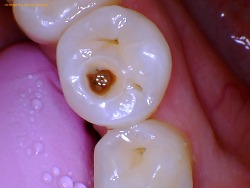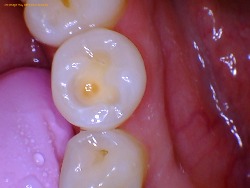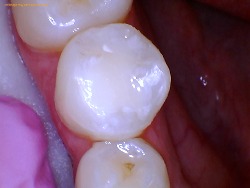Tooth decay can affect any of the 5 surfaces of a tooth and a cavity filling is required to restore and repair the damaged enamel. Since there are multiple surfaces present on teeth, the cavity can affect multiple surfaces in various combinations.

Two of the most common surface combinations would be a one surface filling and a two surface filling. As their name implies, each one affects a certain number of surfaces on the tooth.
We will go over all of the differences and compare these two types of fillings but we'll start with a table summary below.
Attributes | 1 Surface Filling | 2 Surface Filling |
|---|---|---|
# of surfaces affected | One | Two |
Affected surfaces | M, O, D, B, L | MO, DO, BO, OL, BL |
Size | Small | Medium |
15-30 mins | 30-45 mins | |
Cost | $ | $$ |
Table of Contents:
Definitions
The semantics between a one and two surface filling are important because they convey specific information about your cavity and how to treat it.
Conveyed information:
The extent and severity of the decay such as how big the cavity is.
Any additional restorative material that is required to repair the decay.
Ultimately, these two pieces of information let your dentist know what to expect and how to best treat your tooth's condition.
What is a 1 surface filling?
A one surface filling is a dental treatment for restoring a cavity that affects one surface of a tooth. If the decay encompasses more than a single surface, this term would no longer apply.
Examples of a filling with one surface on tooth 14:
14-O involves the occlusal surface only.
14-L involves the lingual surface only.
14-B involves the buccal surface only.
14-M involves the mesial surface only.
14-D involves the distal surface only.

What is a 2 surface filling?
A two surface filling is a dental treatment for restoring a cavity that affects two surfaces of a tooth. If the decay involves more than two surfaces or less than two surfaces, this term would no longer apply.
Examples of a filling with two surfaces on tooth 14:
14-MO involves the mesial and occlusal surface.
14-DO involves the distal and occlusal surface.
14-OL involves the occlusal and lingual surface.
14-OB involves the occlusal and buccal surface.
14-BL involves the buccal and lingual surface.
What they look like
The main difference in how the various surface fillings look is based on how many and which surfaces the filling material is located at.
A filling with one surface only occupies a single surface but it can be any of the 5 surfaces of the tooth.
A filling with two surfaces can occupy two surfaces which can be connected or separate.
Photos
Below is a sequence of photos documenting a one surface cavity. It gets fully excavated where the decay is removed and then a 1 surface filling is placed.
Below is a sequence of photos documenting an in between cavity involving two surfaces. It gets fully excavated and then restored with a 2 surface filling.
Procedure differences
A dental filling for a 2 surface filling can be very different from a 1 surface filling if the cavity involves the interproximal surfaces, mesial and distal.
In order to restore the in between surfaces (interproximal) a matrix band or mylar strip is required. Its purpose is to prevent the filling from bonding to the adjacent tooth. This additional piece of equipment is not needed for a single surface restoration.
Key points in video:
Single surface cavity fillings do NOT require an additional step (placement of matrix band).
Two surface cavity fillings do require a matrix band to prevent the filling from bonding to the adjacent tooth.
Aside from the need of placing a matrix band or mylar strips before filling the tooth, the rest of the tooth filling procedure remains identical.
Identical shared steps of the procedure:
Administering anesthesia.
Removing the cavity by drilling.
Placing the filling material and curing it.
Adjusting and polishing the filling.
Cost
A filling that involves two surfaces will cost more than a filling that only involves a single surface because it is a bigger cavity.
Average costs:
Average cost of a one surface filling is $210.
Average cost of a two surface filling is $275
# surface filling | Average Cost | Cost Range |
|---|---|---|
1 surface filling | $210 | $150-$285 |
2 surface filling | $275 | $200-$360 |
Reasons for increased cost:
It is bigger so it requires more work to drill out the decay.
It also requires more filling material to restore the tooth back to a proper shape.
Last but not least, we also gave you a range of the potential costs because the cost of living in your area affects the price. If you live in a lower cost of living city, you can expect to pay less. Although if you live in a high cost of living city, you should expect to pay more.
Takeaway
Both 2 surface and 1 surface fillings are still dental fillings but the main difference between them is the number of surfaces the decay involves. Of course the two surface one would be a much bigger and more expensive procedure than the single surface one.
We suppose the moral of the story is to take care of cavities while they're small so you pay less to fix them!









